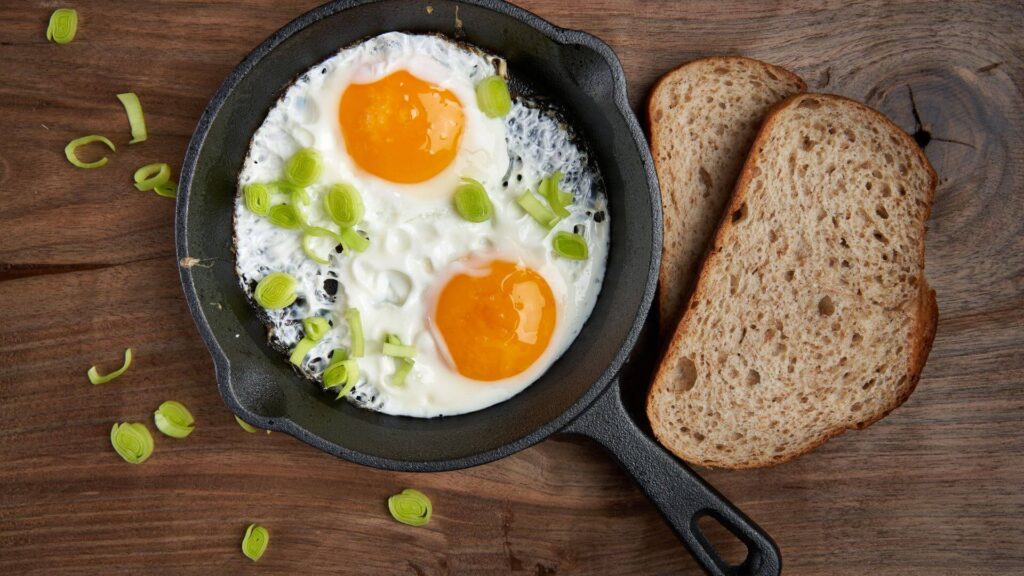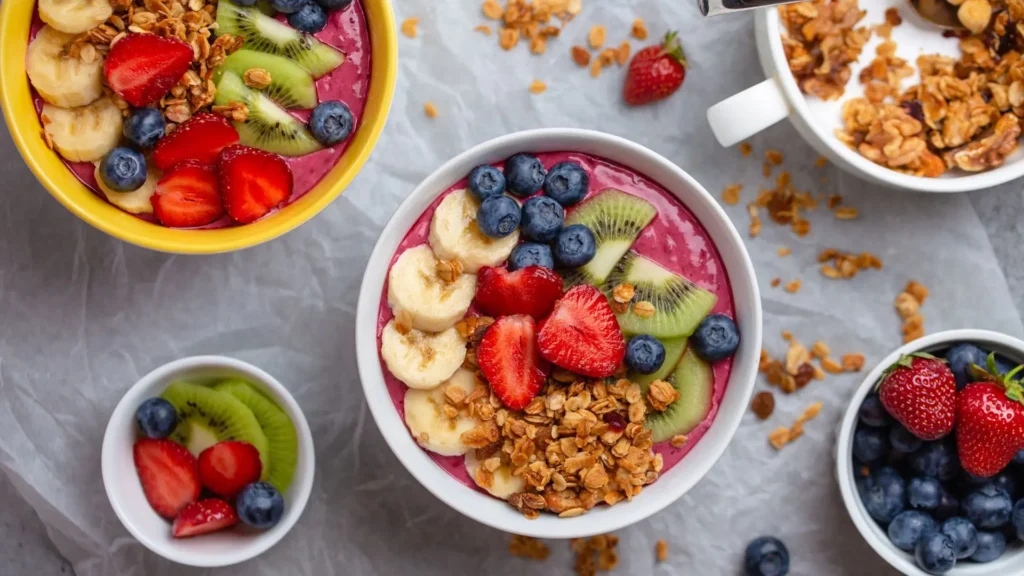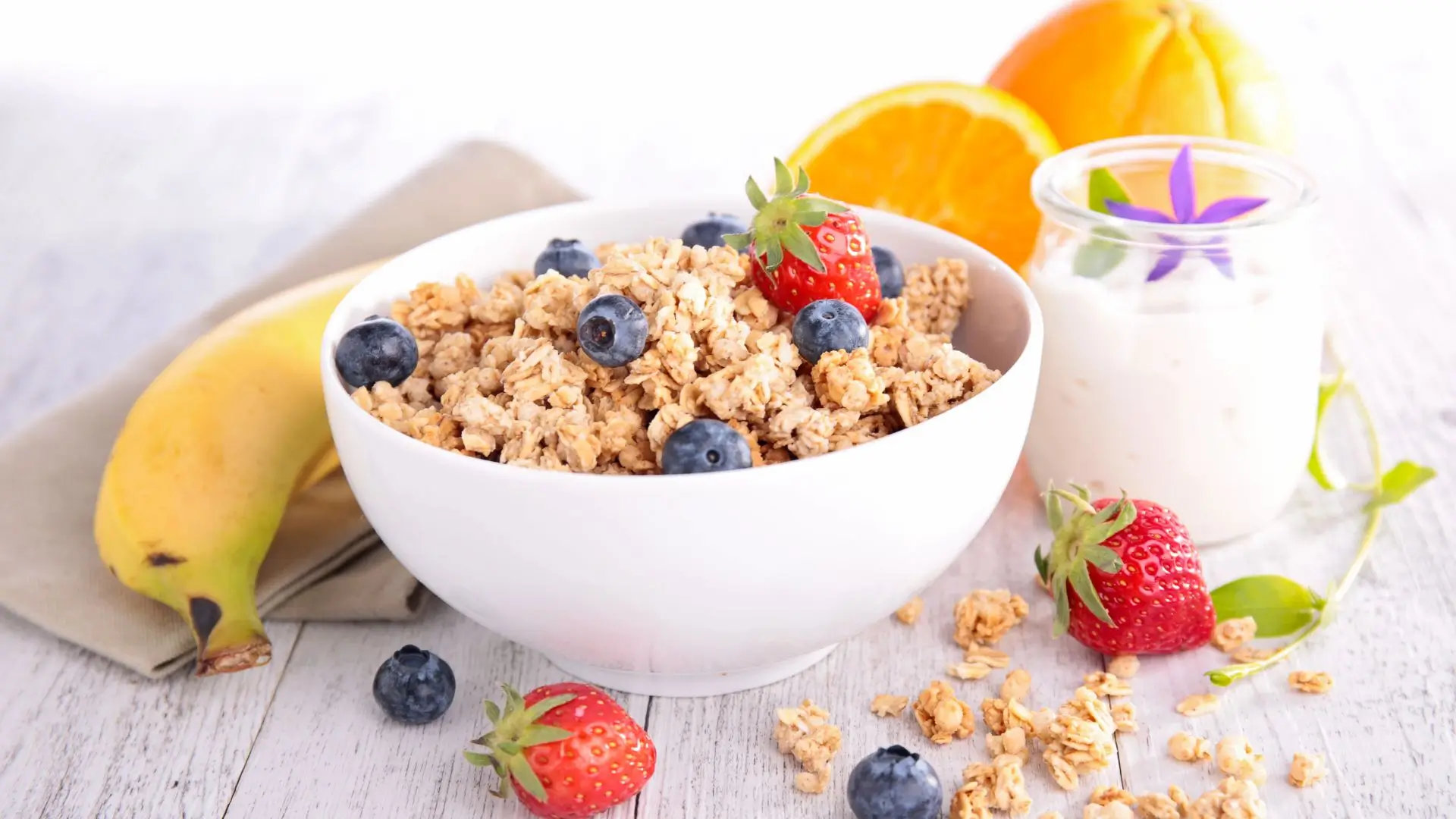Table of Contents
Starting your day with a nutritious meal is key. But, traditional breakfast options often include bread. You might want a change or need to avoid bread for health reasons.
Imagine starting your morning with a delicious and healthy meal without bread. It’s not only possible but also quite easy. You can enjoy many nutritious breakfast options that are satisfying and don’t include bread.

Discover five easy and healthy morning meal ideas to kick-start your day without bread. These bread-free breakfast ideas are simple, nutritious, and fun to make.
Key Takeaways
- Explore nutritious breakfast options beyond traditional bread-based meals.
- Discover easy-to-make bread-free breakfast ideas.
- Learn how to start your day with a healthy and satisfying meal.
- Find out how to incorporate variety into your morning routine.
- Enjoy simple and delicious breakfast options that are bread-free.
The Benefits of Starting Your Day Without Bread
Starting your day without bread is more than a trend. It’s a healthier choice. By skipping traditional bread, you can avoid common health issues. Many people now choose gluten-free breakfast options and low-carb breakfast recipes for better health.
Common Health Concerns with Daily Bread Consumption
Daily bread can lead to health problems. Gluten intolerance affects many people. It causes digestive issues, fatigue, and more in sensitive individuals. Also, traditional bread has a lot of carbs, causing blood sugar to spike quickly.
| Health Concern | Impact of Daily Bread Consumption |
|---|---|
| Gluten Intolerance | Digestive issues, fatigue |
| High Carbohydrate Intake | Rapid increase in blood sugar levels |
Energy and Digestive Advantages of Bread-Free Mornings
Choosing a bread-free breakfast boosts your energy and digestion. Low-carb breakfast recipes keep your energy stable. Gluten-free options also ease digestive discomfort, making you feel lighter and more energized.
Popular Bread-Free Breakfast Ideas for Every Lifestyle
More people are looking for bread-free breakfast ideas. They want healthier and more varied morning meals. This search is for those on special diets or just wanting to try something new.
Why Americans Are Shifting Away from Traditional Toast
Many Americans are choosing grain-free breakfast recipes for good reasons. They want meals that are both tasty and nutritious. This change is also because of the growing importance of a good breakfast.
The rise of diets like keto and paleo has made no bread breakfast choices more popular. These diets focus on protein and veggies, making breakfast both filling and healthy.
How Different Dietary Approaches Handle Morning Meals
Different diets have their own ways of making breakfast. For example, the keto diet uses eggs, avocado, and spinach. The paleo diet, on the other hand, uses veggies as bases for breakfast.
It’s all about finding tasty meals that fit your health goals. Trying grain-free breakfast recipes is a great way to start a new morning routine.
Protein-Packed Egg and Vegetable Bowls
Looking for a protein-packed breakfast that’s easy to make? Try an egg and vegetable bowl. It’s tasty and fits well with keto breakfast recipes. It also gives you a protein-packed breakfast to keep you going all morning.
Base Recipe and Essential Ingredients
A great egg and vegetable bowl starts with eggs, various vegetables, and healthy fats. You can pick your favorite vegetables and proteins to make it your own.
Vegetable Combinations for Maximum Nutrition
For the best nutrition, mix vegetables like spinach, bell peppers, and mushrooms. They’re full of vitamins and minerals. Plus, they add flavor and texture to your bowl.
Protein Options Beyond Just Eggs
Eggs are great for protein, but you can also add grilled chicken, turkey bacon, or tofu. This boosts the protein in your bowl.
Flavor Profiles from Around the World
Make your egg and vegetable bowl global by adding different flavors. Try Korean chili flakes for spice or Mediterranean herbs like oregano and thyme for a milder taste.
Meal Prep Strategies for Weekday Mornings
Make mornings easier by meal prepping your egg and vegetable bowls on weekends. Cook your eggs and veggies, then portion them out in containers. Reheat as needed during the week.
| Ingredient | Nutritional Benefit | Example |
|---|---|---|
| Eggs | High-quality protein | Poached or scrambled |
| Vegetables | Rich in vitamins and minerals | Spinach, bell peppers, mushrooms |
| Healthy Fats | Supports heart health | Avocado, olive oil |
Nutrient-Rich Smoothie Bowls and Yogurt Parfaits
Smoothie bowls and yogurt parfaits are great for breakfast. They’re good for those who need dairy-free breakfast options or just want something new. These dishes are tasty and healthy.
Building the Perfect Smoothie Bowl Base
The base of a smoothie bowl is key. You can make a healthy base with frozen fruits and a liquid like almond milk. Try using berries or bananas with almond milk or coconut water.
Protein-Boosting Add-ins
To add protein, use Greek yogurt, protein powder, or nut butters. These not only taste good but also give you a nutritional boost.
Natural Sweeteners and Flavor Enhancers
For sweetness or flavor, try honey or maple syrup, and vanilla or cinnamon. These add flavor without refined sugars.
Layering Techniques for Instagram-Worthy Parfaits
Making parfaits look good is an art. Start with yogurt or a smoothie base. Then add fresh fruits, granola, or nuts. Keep layering for a balanced and pretty breakfast.
Storage Solutions for Pre-Made Components
Make your breakfast quicker by preparing parts ahead. Store them in airtight containers in the fridge for a day or freeze for longer. This way, you can quickly make your breakfast in the morning.
By using these tips, you can enjoy a tasty, healthy, and pretty meal. It will meet your dietary needs and preferences.
- Try different fruits and toppings to find your favorite.
- Use seasonal fruits to keep your breakfast interesting.
- Be creative with your toppings – the more colorful, the better!
Savory Breakfast Stuffed Vegetables
Stuffed vegetables are a great paleo breakfast choice. They are healthy and full of flavor. You can fill them with many different ingredients to suit your taste.
Selecting and Preparing Vegetables for Stuffing
Picking the right vegetables is important for a tasty breakfast. Look for ones that taste good and can hold their fillings well.
Bell Peppers, Tomatoes, and Avocados
Bell peppers, tomatoes, and avocados are top picks. Bell peppers are crunchy and sweet. Tomatoes add juicy flavor. Avocados are creamy and perfect for fillings.
Seasonal Options Throughout the Year
Using seasonal veggies keeps your breakfast interesting. Zucchini and squash are great in summer. Mushrooms and squash are better in fall and winter.
Filling Mixtures That Satisfy and Energize
Get creative with your fillings. Use eggs, cheese, meats, and spices. For a protein-rich breakfast, try eggs, sausage, or tofu. Herbs and spices add flavor without extra calories.
“The key to a great stuffed vegetable is balancing flavors and textures, making each bite a delightful experience.”
Chef’s Insight
Cooking Methods from Quick to Slow
There are many ways to cook stuffed vegetables. For a fast breakfast, sauté them in a pan for under 10 minutes. For a slow-cooked meal, use a crockpot. This lets flavors blend for hours.
| Cooking Method | Time | Result |
|---|---|---|
| Sautéing | Under 10 minutes | Tender and slightly caramelized |
| Baking | 20-30 minutes | Soft and fully cooked |
| Slow Cooking | 2-4 hours | Richly flavored and tender |
Grain-Free Breakfast Porridges and Hot Cereals
Starting your day with a warm, comforting bowl of grain-free porridge can change your breakfast routine. These porridges and hot cereals are tasty and fit many diets, like low-carb and keto.

Cauliflower, Nut, and Seed Based Alternatives
Cauliflower, nuts, and seeds are key for grain-free porridges. Cauliflower can be made into a rice-like texture and cooked with broth or milk. Nuts and seeds, like almonds and chia seeds, can be ground or soaked to make a porridge.
Texture Considerations and Adjustments
Texture is important for enjoying grain-free porridges. You can change the texture by adding more or less liquid. For a thicker porridge, use less liquid. For a thinner one, add more milk or water.
Warming Spice Combinations
Warming spices like cinnamon, nutmeg, or ginger can make your porridge better. They add flavor and might have health benefits, like fighting inflammation.
Sweet vs. Savory Flavor Directions
Grain-free porridges can be sweet or savory. For sweetness, add fruits or honey. For a savory taste, mix in herbs, spices, or veggies.
- Add fresh or dried fruits for natural sweetness.
- Use nutmeg or cinnamon for a warm, spicy flavor.
- Mix in some sautéed vegetables for a savory twist.
Make-Ahead Methods for Busy Households
Make grain-free porridge ahead of time to save morning time. You can make individual servings in jars or containers the night before. Then, refrigerate and reheat as needed.
- Prepare your grain-free porridge base.
- Portion it into individual containers.
- Reheat and add your choice of toppings or mix-ins in the morning.
Adding grain-free breakfast porridge ideas to your routine can start your day right. You can enjoy a nutritious, satisfying meal without traditional grains.
Protein-Forward Breakfast Wraps Without Bread
You can have a tasty breakfast wrap without bread. Look for a good wrapping alternative. It should hold your filling and match its taste.
Leafy Greens and Vegetable-Based Wrappers
Leafy greens like lettuce and collard greens are great for wraps. They’re low in calories and full of nutrients. Plus, they’re easy to shape around your favorite fillings.
Preparing Leaves for Maximum Flexibility
To make leaves more flexible, blanch them briefly. This helps them wrap around fillings without tearing.
Vegetable Sheets and Alternative Wraps
Thinly sliced veggies can also be used as wraps. Zucchini and sweet potatoes are good options. They add a unique texture and taste.
Fillings That Won’t Sog or Spill
Choose fillings like scrambled eggs, turkey sausage, or tofu for a protein-rich breakfast. Add veggies and cheese for extra flavor.
Assembly and Transport Techniques
To make your wrap, lay the wrapper flat, add fillings, and fold it tight. For transport, wrap in parchment paper or a reusable cloth. This keeps your breakfast fresh and intact.
| Wrapper Type | Fillings | Tips |
|---|---|---|
| Leafy Greens | Eggs, Turkey Sausage | Blanch leaves for flexibility |
| Vegetable Sheets | Tofu, Vegetables | Use a mandoline for thin slices |
Follow these tips for a protein-rich breakfast wrap without bread. It makes mornings healthier and more fun.
“The food you eat can either be the safest and most powerful form of medicine, or the slowest form of poison.”
Ann Wigmore
Nutritional Balance in Your Bread-Free Breakfast Routine
When you start a bread-free breakfast, it’s key to balance your nutrition. Your meal should give you the energy you need for the morning. It must be well-rounded and packed with nutrients.
Begin by adding different food groups to your breakfast. Include protein from eggs, nuts, or seeds. Add vegetables and healthy fats too. A balanced breakfast must also have fiber for good digestion.
Ensuring Adequate Fiber Without Traditional Grains
Fiber is vital for a healthy breakfast. It helps with digestion and keeps you full. You can get enough fiber without grains by eating:
- Vegetables like broccoli, carrots, and spinach
- Fruits such as berries, apples, and bananas
- Nuts and seeds like almonds, chia seeds, and flaxseeds
- Legumes, including beans and lentils
Adding these foods to your breakfast helps you meet your fiber needs.
Creating Meals That Sustain Energy Levels
Your breakfast should mix protein, healthy fats, and complex carbs to keep energy up. Avoid foods high in sugar or refined carbs to prevent energy drops later.
Try a breakfast bowl with spinach, avocado, a fried egg, and chia seeds. This meal is full of nutrients and keeps your energy up.

Essential Kitchen Tools for Bread-Free Breakfast Success
Having the right tools in your kitchen makes bread-free breakfasts easier. The right equipment saves time and ensures your meals are made safely and efficiently. Whether you’re busy or love cooking, the right tools can really help.
Basic Equipment That Makes Morning Prep Easier
To start your day right, you need some basic tools. A non-stick skillet is key for cooking eggs and veggies. A high-speed blender is also a must for smoothies and blended dishes. Plus, a sharp chef’s knife and cutting board help you prep quickly and safely.
| Tool | Use | Benefit |
|---|---|---|
| Non-stick Skillet | Cooking eggs and vegetables | Easy food release, less cleanup |
| High-Speed Blender | Making smoothies and blended dishes | Fast and efficient blending |
| Sharp Chef’s Knife | Chopping ingredients | Safe and efficient preparation |
Advanced Gadgets for Enthusiastic Home Cooks
If you like trying new recipes, advanced gadgets can take your breakfasts to the next level. A food dehydrator is great for grain-free granola. A spiralizer makes veggie noodles. An Instant Pot or pressure cooker cooks breakfasts fast.
Adapting These Ideas for Special Dietary Requirements
Changing your breakfast to fit dietary needs is easy and tasty. You can make the bread-free breakfast ideas work for you, no matter your diet or food allergies.
Modifications for Keto, Paleo, and Low-Carb Lifestyles
If you’re on keto, paleo, or low-carb, breakfast can be made with high-fat, moderate-protein, and low-carb foods. Try keto breakfast recipes with avocado, eggs, and healthy oils. Paleo diets use veggies, nuts, and seeds for breakfast bowls or smoothies.
Add protein like bacon, sausage, or eggs, and healthy fats like nuts or avocado. This makes your meal tasty and filling, while following your diet.
Solutions for Common Food Allergies and Sensitivities
For common food allergies or sensitivities, like gluten intolerance or dairy allergies, you can still have many breakfast options. For dairy-free breakfast options, use almond milk, coconut milk, or cashew cream instead of dairy. For gluten-free breakfast options, pick gluten-free oats or other grains and watch for cross-contamination.
Being careful with ingredients and making simple swaps can make breakfast safe and fun. Always check labels and talk to a healthcare professional or dietitian for advice.
Conclusion: Embracing a Healthier Morning Routine
You now have many healthy morning meal ideas without bread. Try egg and vegetable bowls, smoothie bowls, or grain-free porridges. These options are exciting and full of nutrients.
Exploring different diets and meal prep can make your mornings better. You can make a breakfast plan that fits your life and diet. Use the ideas and tips you’ve learned.
Begin your healthier morning routine today. Try new ingredients and recipes. With the right tools and creativity, you’ll enjoy tasty, bread-free breakfasts soon. Dive into healthy morning meals and feel more energized and focused.
FAQ
What are some popular bread-free breakfast ideas?
Try egg and vegetable bowls, smoothie bowls, and yogurt parfaits. You can also make savory breakfast stuffed vegetables. Grain-free breakfast porridges and protein-forward breakfast wraps are great options too.
How can I ensure I’m getting enough fiber without traditional grains for breakfast?
Eat fiber-rich foods like vegetables, nuts, seeds, and some fruits. Add them to egg bowls, smoothie bowls, or use as fillings in wraps.
Are there any keto breakfast recipes that are bread-free?
Yes, many keto breakfasts don’t need bread. Try egg and vegetable bowls with avocado and spinach. Or, make keto smoothie bowls with almond milk and protein powder, topped with nuts and seeds.
Can I make dairy-free breakfast options?
Absolutely. Use almond milk, coconut yogurt, or cashew cream in your smoothie bowls, yogurt parfaits, or grain-free porridges.
How do I modify these breakfast ideas for a low-carb diet?
For a low-carb diet, cut down on high-carb foods. Limit fruit in smoothie bowls and choose low-carb veggies for egg bowls. Be careful with ingredients in grain-free porridges.
What are some gluten-free breakfast options that are also bread-free?
Many ideas are naturally gluten-free and bread-free. Try egg and vegetable bowls, smoothie bowls with gluten-free ingredients, and grain-free porridges from cauliflower, nuts, or seeds.
How can I meal prep these bread-free breakfast ideas for the week?
Meal prep by chopping veggies for egg bowls, making grain-free porridge, or preparing smoothie or yogurt parfait ingredients. This way, you can assemble your breakfast quickly in the morning.

